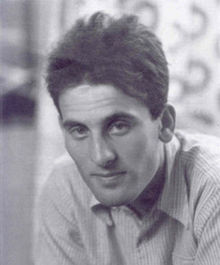Giuseppe Occhialini
| Giuseppe Occhialini | |
|---|---|
 |
|
| Born |
5 December 1907 Fossombrone, Pesaro, Italy |
| Died | 30 December 1993 (aged 86) Paris, France |
| Doctoral advisor | Bruno Rossi |
| Known for | Contribution to the discovery of the pion or pi-meson decay |
Giuseppe Paolo Stanislao "Beppo" Occhialini ForMemRS (Italian pronunciation: [dʒuˈzɛppe okkjaˈliːni]; 5 December 1907 – 30 December 1993) was an Italian physicist, who contributed to the discovery of the pion or pi-meson decay in 1947, with César Lattes and Cecil Frank Powell (Nobel Prize for Physics). At the time of this discovery, they were all working at the H. H. Wills Laboratory of the University of Bristol.
The X-ray satellite SAX was named BeppoSAX in his honour after its launch in 1996.
His father was the physicist Raffaele Augusto Occhialini (1878–1951), pioneer in the fields of spectroscopy and electronics theory. Giuseppe Paolo Stanislao Occhialini graduated at Florence in 1929. In 1932, he collaborated in the discovery of the positron in cosmic rays at the Cavendish Laboratory of Cambridge, under the leadership of Patrick Blackett, using cloud chambers. From 1937 to the 1944 he worked, on invitation of Gleb Wataghin, at the institute of physics of the University of São Paulo, in Brazil. He returned to Italy, in 1944, taught first in Genoa (1950) and then in Milan (1952).
In 1947 he contributed to the discovery of the pion or pi-meson decay in collaboration with César Lattes and Cecil Frank Powell. The discovery was made at the Wills Laboratory of Bristol using the technology of the tracks on specialized photographic emulsions.
...
Wikipedia
